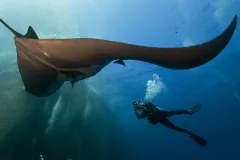Tagging and Tracking Animals Underwater

How do we know where ocean animals swim day and night? Scientists are getting snapshots into the daily lives of whales, sharks, and even fish by tagging the animals to track their movements.
You’ve probably seen photos of the mysterious and almost eerie silhouette of a manta ray. But what do we really know about these giant creatures, which can grow up to 25 ft in width? Not much, but that is changing. Scientists recently attached satellite trackers to six giant manta rays (Manta birostris). They found that the giant fish spent most of their time within 200 miles of shore, but not necessarily in safe spots (only about 12 percent of their time was spent in marine protected areas).
Another recent study looked at the movements of the critically endangered leatherback sea turtles in the Atlantic and Pacific oceans. Scientists found that turtles in the Atlantic swam at two different speeds – one very fast (up to 28 miles per hour!) when they wanted to get somewhere and a slower speed when searching for their next meal. Leatherbacks in the Pacific stuck to one speed in the middle, and had a harder time finding food.
As we learn more about where endangered animals are found, and why, we can better manage them by putting marine protected areas in the places they like to hang out.
Want the details? Check out what the scientists found out about mantas and leatherbacks.


